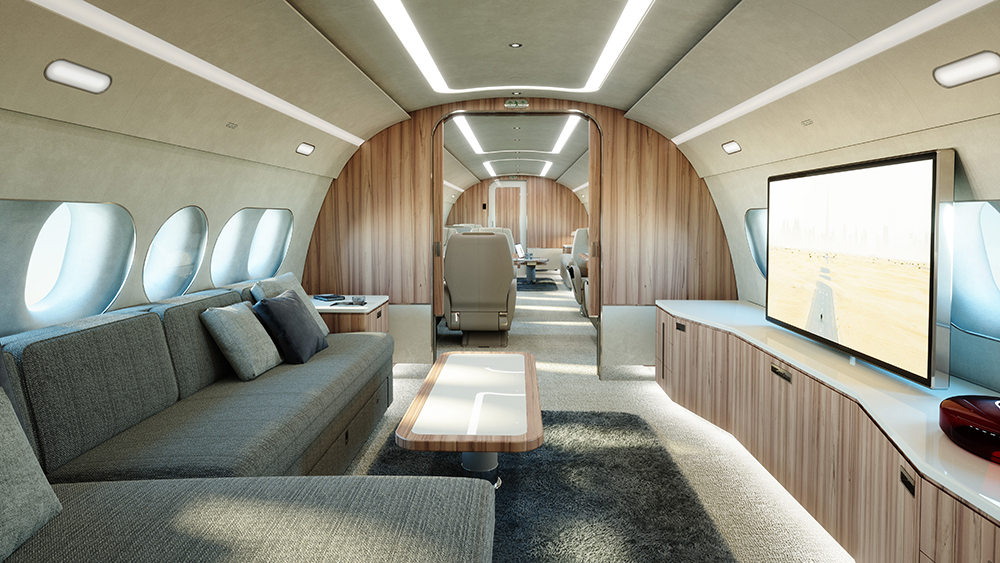Finding a design studio that matches the sophistication of the US$75 million business jet you want to build can be a tricky proposition, since the designers are typically located inside aircraft manufacturing facilities and assembling a jet remains a noisy, industrial activity. But a number of bizjet manufacturers are looking to change that, investing big in an overlooked part of the design process: the client experience.
Bombardier’s Laurent Beaudoin Completion Centre—a luxurious, purpose-built wing across the hall from the bays of Globals in different stages of interior fit-out—bridges the gap between the design and industrial worlds. “We had a delivery center before but decided to customize the visits for each client,” says Katie Papoutsis, head of Bombardier’s customer experience, strategy and operations. “We wanted to make sure the experience is similar to their normal lives.”

Courtesy of Airbus Corporate Jets
Modeled on contemporary five-star hotels, the 150,000-square-foot wing is a sanctum sanctorum used only for clients, with multiple conference rooms, an upscale interiors showroom with hundreds of samples of fabrics, leathers, veneers and countertops and a professional kitchen where executive chef Steve Lemieux and his team concoct five-star dishes for each customer. “The clients convey their food preferences and dietary restrictions, and our chef creates meals around that,” Papoutsis says. “We don’t tell them what they’re eating ahead of time because it would spoil the surprise.”
Gulfstream has also modernized the design center at its Savannah, Ga., headquarters, transforming it into a high-ceilinged showroom for its most popular materials, which are sometimes grouped in collections such as Sports Aesthetic or Minimalist Aesthetic. “They tend to be conversation starters, since our G500/600, for instance, has hundreds of interior options,” says Tray Crow, Gulfstream’s director of interior design. The showroom also includes three full-size interior mock-ups of its new G700, G600 and G400 aircraft. “Having the mock-ups here lets the client walk through to get a sense of scale,” Crow explains.
Of course, some inside spaces are more personalized than others. For Boeing Business Jets, each interior for one of its converted large-body aircraft is created from a blank canvas. “Every one of our designs is through outside designers,” says Alexis Fecteau, global director of marketing, noting the company’s limited build schedule. BBJ works with established design houses such as Andrew Winch and Alberto Pinto and has developed new relationships with firms known for forward-thinking interiors, including SkyStyle and KiPcreating, which work together closely and jointly created the award-winning “Genesis” concept for the BBJ 787.
“We carry a few samples in the studio, but these kinds of customers typically have design advisers who come with very specific ideas,” says Max Pardo, who heads visualization across the two studios. His team relies on hyperrealistic digital mock-ups, so the client can see the interior at scale while also being able to easily visualize different types of materials within the setting.

Cutting-edge technology is becoming increasingly important to the interior-design process, particularly during client meetings. In May, ACJ opened a new ACJ TwoTwenty design center at Airbus headquarters in Toulouse, France, with a full-size cabin, materials selections and VR technology that immerses the customer in potential layouts developed with ACJ’s design team, led by Sylvain Mariat.
“We presented the floorplan a client wanted on the first visit,” says Mariat. “He was surprised we could project on a one- to-one scale. You can look, modify and touch everything before you even buy it.”
But designers must take pains to ensure that the presentational fireworks don’t get ahead of reality. “We take pride in adding creative features that also work with technical requirements,” Mariat explains. That means constant communication with critical counterparts on the engineering side, who field questions about new materials or components meeting regulations for flammability and structural integrity. “We never promise anything we can’t deliver,” he adds, noting a sculptural wood light fixture recently added to the bedroom in a new jet. “If the client wants a reading lamp, he simply touches the wood. It gave a decorative look to the cabin that was also functional.”









